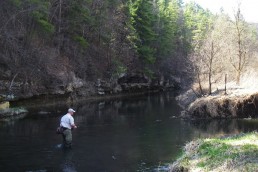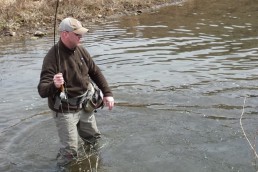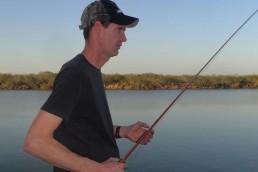Spring Fly Patterns for Stream Trout
SHARE THIS POST
Experienced fly anglers who frequent the “Driftless Area” of southeastern Minnesota, northeast Iowa or western Wisconsin, will tell you that once spring arrives, fishing is nothing short of exceptional with unforgettable days on the water with numbers of trout caught with size.
The major hatches I look forward to in early April are the emergence of blue-winged olives, dark Hendricksons, and later, gray caddis. In my experience, these hatches hinge on a variety of factors including any late-winter weather and the volume of runoff combined with the length of the runoff season. In years with minimal to no flooding, hatches are typically very good. Floodwaters that do not get to the point of rolling over rocks and scouring streams leave the in-stream insects a high- percentage chance of survival, and ultimately hatchings to pass on their brood.
Air temperatures are a major factor too, and if these rise to normal to above-normal levels, which in turn affects the water temperature, insects will hatch on time and in great numbers. When the weather is inconsistent and unseasonably cool, hatches are often delayed.
The first real mayfly hatches are blue-winged olives in late March through April. They like dreary, overcast days, so encountering a good hatch in cooler, rainy weather is not uncommon. This is often a later-in-the-day hatch with adults forming once water temperatures begin to spike. I typically fish a pheasant tail nymph throughout the season, and fishing one during their hatch time is a must. My patterns are dark in color with blacks, browns and olives, and are usually with number 16-18. I also fish an “emerger” period, when there’s no real hatch yet. The key to the pattern is the CDC (cul de canard) wing that undulates and gives trout the illusion it’s a hatching adult. It rides higher in the water column too, which helps give it a “hatching-adult” look.
For dry flies, I stick with small parachute patterns or Adams-type dry flies tied in gray or olive. The parachute approach gives the angler more chances to pick up a small fly drifting on the water. I often tie my post in pink for extra visibility. The sizes in this pattern range from 16-20.
My favorite early-season hatch is the dark Hendrickson. It was one of the first hatches I stumbled upon in my younger fly fishing days, and has stuck with me ever since. Part of my fascination with the dark Hendrickson hatch is that it’s a large fly by southeast Minnesota standards (#12-14), and due to its size, the trout will feed on it with reckless abandon. This hatch gets the attention of every trout in the pod, and the potential to catch some real bruisers on a dry is common.
Are you enjoying this post?
You can be among the first to get the latest info on where to go, what to use and how to use it!
Similar to the blue-winged olive hatch, water temperatures and weather dictate the Hendrickson emergence. My fly fishing log over the past several years has shown that this hatch comes off in late March all the way to April 25. Typically, I’ll start looking for dark Hendricksons in the afternoon hours the first few weeks in April. Nymph rigs for this hatch can consist of larger pheasant tails or hare’s ears in size 12 to emergers in the same size.
The first real caddis action we get in the Midwest is the Little Sister Sedge or the Little Tan Shorthorn Sedge. In simpler terms, most anglers refer to this period as the “gray caddis hatch,” simply due the gray-brown coloration of the pattern itself. Rolling over a few rocks from the stream you’re fishing will typically reveal the state of caddis activity, whether they’re still in the shucks (cased caddis imitations work well), larvae stage or out of the shuck, or are in emergence, meaning they’re out from under the rocks and ready to hatch.
Many anglers will fish caddis larvae or emergers with success, even before the hatch starts. Caddis adults are easy to spot as they typically bounce up and down near the edges of banks triggering fish to rise and feed. Standard gray or dark-tan caddis dry-fly patterns in 14-18 are standard. Look for this hatch to get going in the later morning hours on nice days where the temperatures rise into the 60s.
April is a popular month to fly fish in the Midwest, as there are no shortages of hatches to target. Early spring is a great time to shake off the remnants of winter and put some flies over hungry trout.
MWO
SHARE THIS POST
Did you enjoy this post?
You can be among the first to get the latest info on where to go, what to use and how to use it!
Dave Anderson
Dave Anderson has lived in southeast Minnesota his entire life. He started fly-fishing in the early 1990s and has guided ontheflyguiding.com in the area since 1998.



